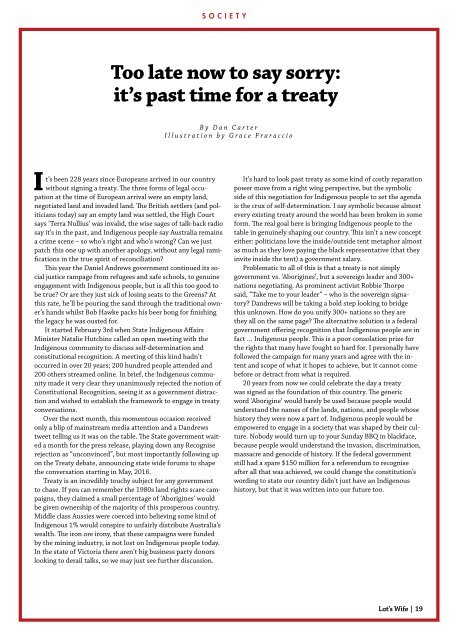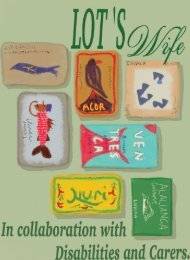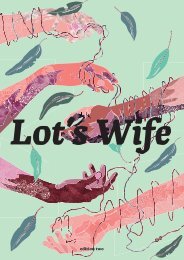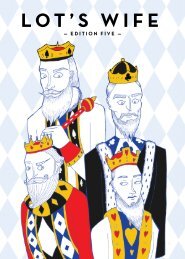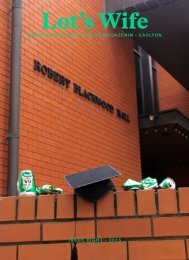Lot's Wife Edition 4 2016
Create successful ePaper yourself
Turn your PDF publications into a flip-book with our unique Google optimized e-Paper software.
SOCIETY<br />
Too late now to say sorry:<br />
it’s past time for a treaty<br />
By Dan Carter<br />
Illustration by Grace Fraraccio<br />
It’s been 228 years since Europeans arrived in our country<br />
without signing a treaty. The three forms of legal occupation<br />
at the time of European arrival were an empty land,<br />
negotiated land and invaded land. The British settlers (and politicians<br />
today) say an empty land was settled, the High Court<br />
says ‘Terra Nullius’ was invalid, the wise sages of talk-back radio<br />
say it’s in the past, and Indigenous people say Australia remains<br />
a crime scene – so who’s right and who’s wrong? Can we just<br />
patch this one up with another apology, without any legal ramifications<br />
in the true spirit of reconciliation?<br />
This year the Daniel Andrews government continued its social<br />
justice rampage from refugees and safe schools, to genuine<br />
engagement with Indigenous people, but is all this too good to<br />
be true? Or are they just sick of losing seats to the Greens? At<br />
this rate, he’ll be pouring the sand through the traditional owner’s<br />
hands whilst Bob Hawke packs his beer bong for finishing<br />
the legacy he was ousted for.<br />
It started February 3rd when State Indigenous Affairs<br />
Minister Natalie Hutchins called an open meeting with the<br />
Indigenous community to discuss self-determination and<br />
constitutional recognition. A meeting of this kind hadn’t<br />
occurred in over 20 years; 200 hundred people attended and<br />
200 others streamed online. In brief, the Indigenous community<br />
made it very clear they unanimously rejected the notion of<br />
Constitutional Recognition, seeing it as a government distraction<br />
and wished to establish the framework to engage in treaty<br />
conversations.<br />
Over the next month, this momentous occasion received<br />
only a blip of mainstream media attention and a Dandrews<br />
tweet telling us it was on the table. The State government waited<br />
a month for the press release, playing down any Recognise<br />
rejection as “unconvinced”, but most importantly following up<br />
on the Treaty debate, announcing state wide forums to shape<br />
the conversation starting in May, <strong>2016</strong>.<br />
Treaty is an incredibly touchy subject for any government<br />
to chase. If you can remember the 1980s land rights scare campaigns,<br />
they claimed a small percentage of ‘Aborigines’ would<br />
be given ownership of the majority of this prosperous country.<br />
Middle class Aussies were coerced into believing some kind of<br />
Indigenous 1% would conspire to unfairly distribute Australia’s<br />
wealth. The iron ore irony, that these campaigns were funded<br />
by the mining industry, is not lost on Indigenous people today.<br />
In the state of Victoria there aren’t big business party donors<br />
looking to derail talks, so we may just see further discussion.<br />
It’s hard to look past treaty as some kind of costly reparation<br />
power move from a right wing perspective, but the symbolic<br />
side of this negotiation for Indigenous people to set the agenda<br />
is the crux of self-determination. I say symbolic because almost<br />
every existing treaty around the world has been broken in some<br />
form. The real goal here is bringing Indigenous people to the<br />
table in genuinely shaping our country. This isn’t a new concept<br />
either: politicians love the inside/outside tent metaphor almost<br />
as much as they love paying the black representative (that they<br />
invite inside the tent) a government salary.<br />
Problematic to all of this is that a treaty is not simply<br />
government vs. ‘Aborigines’, but a sovereign leader and 300+<br />
nations negotiating. As prominent activist Robbie Thorpe<br />
said, “Take me to your leader” – who is the sovereign signatory?<br />
Dandrews will be taking a bold step looking to bridge<br />
this unknown. How do you unify 300+ nations so they are<br />
they all on the same page? The alternative solution is a federal<br />
government offering recognition that Indigenous people are in<br />
fact … Indigenous people. This is a poor consolation prize for<br />
the rights that many have fought so hard for. I personally have<br />
followed the campaign for many years and agree with the intent<br />
and scope of what it hopes to achieve, but it cannot come<br />
before or detract from what is required.<br />
20 years from now we could celebrate the day a treaty<br />
was signed as the foundation of this country. The generic<br />
word ‘Aborigine’ would barely be used because people would<br />
understand the names of the lands, nations, and people whose<br />
history they were now a part of. Indigenous people would be<br />
empowered to engage in a society that was shaped by their culture.<br />
Nobody would turn up to your Sunday BBQ in blackface,<br />
because people would understand the invasion, discrimination,<br />
massacre and genocide of history. If the federal government<br />
still had a spare $150 million for a referendum to recognise<br />
after all that was achieved, we could change the constitution’s<br />
wording to state our country didn’t just have an Indigenous<br />
history, but that it was written into our future too.<br />
Lot’s <strong>Wife</strong> | 19


